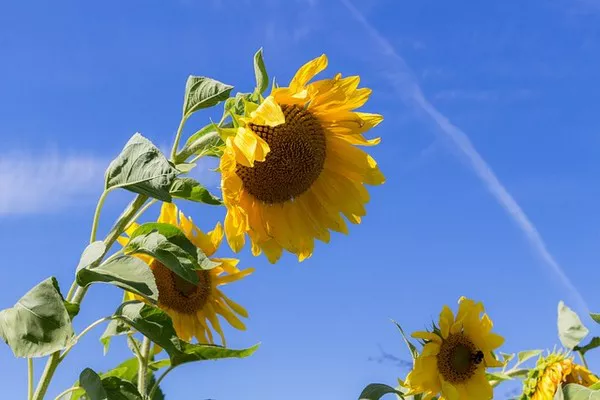Sunflowers are not only beautiful additions to gardens and landscapes, but they also provide numerous environmental benefits. Once they reach the end of their blooming cycle, sunflower stalks can be a valuable resource if managed properly. Instead of discarding them as waste, homeowners, gardeners, and farmers can adopt various sustainable practices to make the most of these dead sunflower stalks. In this article, we will explore several eco-friendly ways to handle dead sunflower stalks, promoting a more sustainable approach to gardening and agriculture.
Composting Sunflower Stalks
Composting is one of the most eco-friendly methods of recycling organic waste, including dead sunflower stalks. Composting breaks down the stalks into nutrient-rich soil amendments that can enhance the fertility of the garden. To compost sunflower stalks effectively, follow these steps:
a. Cut the Stalks: Chop the sunflower stalks into smaller pieces to accelerate the decomposition process. Removing large flower heads and leaves will also help the stalks decompose faster.
b. Mix with Green and Brown Material: Composting requires a mix of green (nitrogen-rich) and brown (carbon-rich) materials. Combine the chopped sunflower stalks with green materials such as kitchen scraps and grass clippings, as well as brown materials like dry leaves and straw.
c. Turn the Compost Pile: Regularly turning the compost pile allows for proper aeration and even decomposition. Ensure the compost remains moist but not soggy.
d. Patience and Time: Composting is a gradual process that requires time for the organic matter to break down. Within several months to a year, the sunflower stalks will transform into nutrient-dense compost.
Mulching Sunflower Stalks
Mulching with dead sunflower stalks is an excellent way to enrich the soil and retain moisture, while also preventing weed growth. Follow these steps to effectively mulch with sunflower stalks:
a. Cut and Spread: After sunflower stalks have dried out, cut them into smaller pieces and spread them over the soil surface.
b. Mulch Depth: Aim for a mulch depth of about 2 to 3 inches to provide adequate coverage and protection to the soil.
c. Natural Decomposition: As the sunflower stalks decompose over time, they release valuable nutrients into the soil, improving its fertility.
d. Renewal: Depending on the rate of decomposition, add fresh sunflower stalk mulch annually or as needed to maintain the desired depth.
Feeding Wildlife with Sunflower Seeds
Sunflower seeds are a popular and nutritious food source for various wildlife, including birds and small mammals. Before disposing of dead sunflower heads, consider these steps to feed wildlife:
a. Allow Seeds to Mature: After the sunflower petals have wilted and the flower head droops downward, let the seeds mature on the flower head. This typically takes several weeks.
b. Harvesting Seeds: Once the seeds have fully matured, cut the sunflower head from the stalk and place it in a paper bag. Allow the sunflower head to dry further indoors for about two weeks.
c. Placing the Sunflower Heads: Position the sunflower heads on elevated platforms or hang them from tree branches to provide easy access for birds and other wildlife.
d. Observe and Refill: Observe the wildlife as they feed on the sunflower seeds, and remember to refill the feeding stations as needed.
Biomass Energy Production
Dead sunflower stalks can also be utilized as a renewable source of biomass energy. Biomass energy production involves converting organic materials into useful forms of energy like biogas or biofuels. To use sunflower stalks for biomass energy:
a. Pellet Production: Sunflower stalks can be compressed and pelletized to create biomass pellets. These pellets can be used in pellet stoves for heating or in biomass power plants for electricity generation.
b. Biogas Production: Sunflower stalks can be mixed with other organic waste in anaerobic digesters to produce biogas. Biogas is a renewable energy source that can be used for cooking, heating, or electricity generation.
c. Biofuel Extraction: Sunflower stalks contain oil-rich seeds that can be processed to extract biofuels like biodiesel. Biodiesel is a sustainable alternative to conventional diesel fuel.
Crafting and Art Projects
Creativity knows no bounds, and dead sunflower stalks can be repurposed for crafting and art projects. Engage your artistic side and follow these steps:
a. Sunflower Stalk Art: Create sculptures, wall hangings, or decorative pieces using the stalks’ natural shape and texture.
b. Sunflower Stalk Pulp: Blend sunflower stalks with water to create a pulp that can be molded into various shapes. Once dried, the pulp can be painted or adorned with different embellishments.
c. Dyeing: Sunflower stalks can be used to dye fabrics or paper, producing unique and eco-friendly colors.
d. Garden Decorations: Use sunflower stalks to craft trellises, plant markers, or garden borders.
Soil Erosion Control
For land and garden areas prone to erosion, dead sunflower stalks can be employed as a natural erosion control method. Follow these steps to use sunflower stalks for erosion control:
a. Arrange the Stalks: Place the sunflower stalks horizontally along the contours of the landscape or the slope facing downhill.
b. Secure in Place: Use stakes or weave the stalks together to keep them in position. This will prevent the soil from washing away during heavy rain or wind.
c. Decomposition and Soil Enhancement: As the sunflower stalks decompose, they enrich the soil and contribute to the establishment of vegetation, further preventing erosion.
Conclusion
Dead sunflower stalks can be transformed from mere garden waste into valuable resources that promote sustainable practices. Composting, mulching, wildlife feeding, biomass energy production, crafting, and erosion control are all eco-friendly ways to make the most of these stalks. By adopting these practices, gardeners, farmers, and homeowners can minimize waste, improve soil health, and contribute to a more sustainable environment. Embracing these innovative uses for dead sunflower stalks not only benefits the individual but also the larger community and the planet as a whole. It is our responsibility to tread lightly on the Earth and ensure that even in their afterlife, sunflowers continue to brighten and enrich our lives sustainably.


